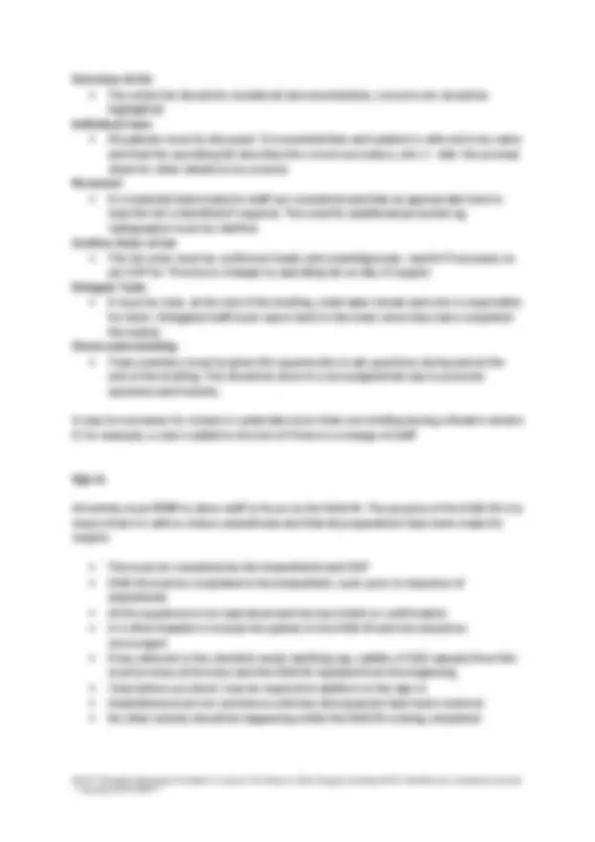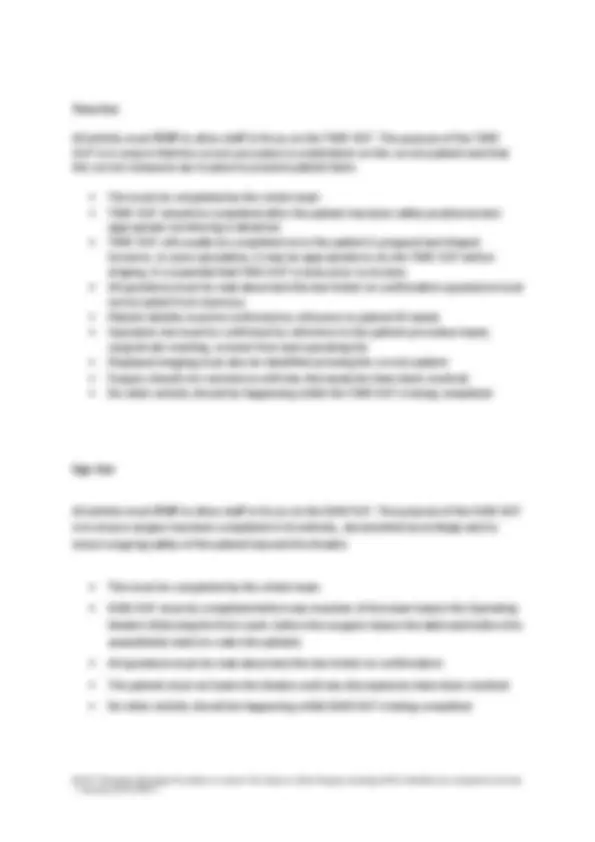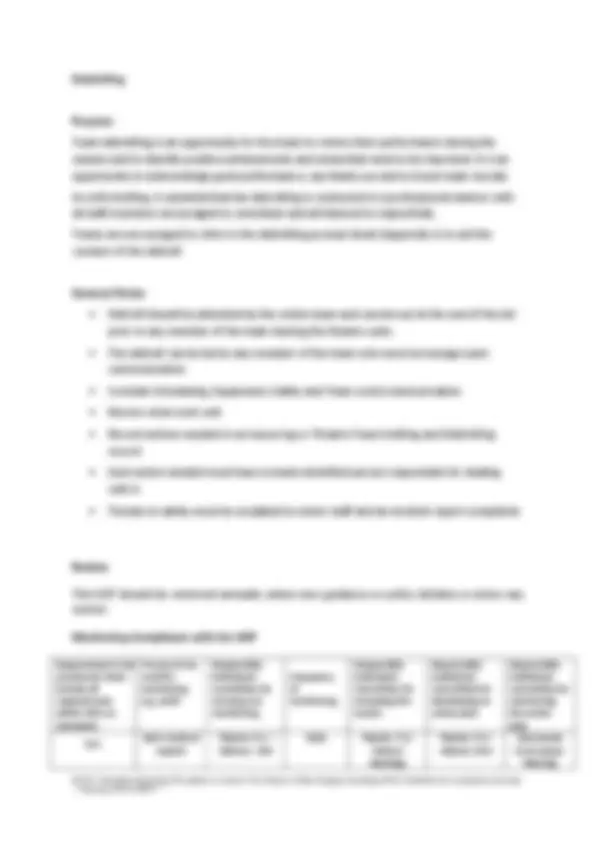





Study with the several resources on Docsity

Earn points by helping other students or get them with a premium plan


Prepare for your exams
Study with the several resources on Docsity

Earn points to download
Earn points by helping other students or get them with a premium plan
Community
Ask the community for help and clear up your study doubts
Discover the best universities in your country according to Docsity users
Free resources
Download our free guides on studying techniques, anxiety management strategies, and thesis advice from Docsity tutors
A Standard Operating Procedure (SOP) for ensuring compliance with the World Health Organization (WHO) checklist for Safer Surgery. The SOP includes the background of the initiative, the scope of the process, and detailed instructions for briefing and debriefing sessions. The purpose is to improve patient safety and reduce serious incidents during surgery.
What you will learn
Typology: Study Guides, Projects, Research
1 / 6

This page cannot be seen from the preview
Don't miss anything!




STANDARD OPERATING PROCEDURE TO ENSURE “FIVE STEPS TO SAFER SURGERY” INCLUDING “WHO” CHECKLIST ARE COMPLETED CORRECTLY.
Process Name: (^) Process to ensure compliance with 5 Steps to Safer Surgery
SOP Number: (^) WHO checklist Version Number: 1 Effective Date: (^) 01/02/2018 Review Date: 31/05/ Author: (^) Wendy Hartley
Process Owner: (^) Anaesthetics and Surgery Directorate Name/Position: (^) Directorate Manager Date Approved: May 2018
Background
The Safer Surgery Saves Lives initiative was launched by the World Health Organisation (WHO) in 2008 to reduce the number of surgical errors and enhance patient safety during the perioperative phase of their care. The launch saw the introduction of a surgical safety checklist. The Five Steps to Safer Surgery was introduced in 2010. It is a process for improving the way theatre teams communicate with each other. It consists of 5 steps:
**1. Briefing
The WHO surgical safety checklist forms steps 2, 3 and 4 of the five steps.
Assessment
The WHO surgical safety checklist is a core set of safety checks, identified for improving performance at safety critical time points within the patients perioperative journey. The 3 steps in the checklist are not intended as a tick-box exercise but as a tool to initiate effective communication between the clinical team. The WHO checklist should be carried out for all patients including those having procedures under Local anaesthetic or sedation. The Briefing and Debriefing should be carried out for all theatre lists and should include all members of the theatre team.
Objectives
BTHFT Standard Operating Procedure to ensure Five Steps to Safer Surgery including WHO Checklist are completed correctly
Scope
Briefing to be carried out prior to the start of all theatre lists and to include the whole team. Debriefing to be carried out at the end of each theatre list and to include the whole team. The WHO Surgical Safety checklist to be completed for all patients. The Five Steps to Safer Surgery to form part of all theatre staff, surgical and anaesthetic trainees induction to the Trust.
Stages of the Process
Briefing
Purpose Team briefing is an opportunity for highly effective face-to-face communication which can enhance team performance however; it must be focused and supportive. Briefing facilitates delivery of clear messages and reduces misunderstandings; it is not just about informing people, but listening and responding to questions and concerns. It is essential that all staff feel able to speak up and that senior members of the team actively welcome queries from more junior ones. Briefing can help to clarify the aims of the team and sets the tone for a professional working environment.
Teams are encouraged to refer to the briefing prompt sheet (Appendix 1) to aid the conduct of the briefing.
General Points
BTHFT Standard Operating Procedure to ensure Five Steps to Safer Surgery including WHO Checklist are completed correctly
Time Out
All activity must STOP to allow staff to focus on the TIME OUT. The purpose of the TIME OUT is to ensure that the correct procedure is undertaken on the correct patient and that the correct measures are in place to prevent patient harm.
Sign Out
All activity must STOP to allow staff to focus on the SIGN OUT. The purpose of the SIGN OUT is to ensure surgery has been completed in its entirety, documented accordingly and to
ensure ongoing safety of the patient beyond the theatre.
BTHFT Standard Operating Procedure to ensure Five Steps to Safer Surgery including WHO Checklist are completed correctly
Debriefing
Purpose Team debriefing is an opportunity for the team to review their performance during the session and to identify positive achievements and areas that need to be improved. It is an opportunity to acknowledge good performance, say thank you and to boost team morale. As with briefing, it essential that the debriefing is conducted in a professional manner with all staff members encouraged to contribute and all listened to respectfully. Teams are encouraged to refer to the debriefing prompt sheet (Appendix 1) to aid the conduct of the debrief.
General Points
Review
This SOP should be reviewed annually unless new guidance or policy dictates a review any sooner.
Monitoring Compliance with the SOP
Requirement to be monitored. Must include all requirements within NHS LA Standards
Process to be used for monitoring e.g. audit
Responsible individual/ committee for carrying out monitoring
Frequency of monitoring
Responsible individual/ committee for reviewing the results
Responsible individual/ committee for developing an action plan
Responsible individual/ committee for monitoring the action plan N/A Datix incidentreports^ Theatre TL’s /Matron / DM^ Daily^ Theatre TL’s/Matron meetings
Theatre TL’s/ Matron /DM
Directorate Governance Meeting BTHFT Standard Operating Procedure to ensure Five Steps to Safer Surgery including WHO Checklist are completed correctly